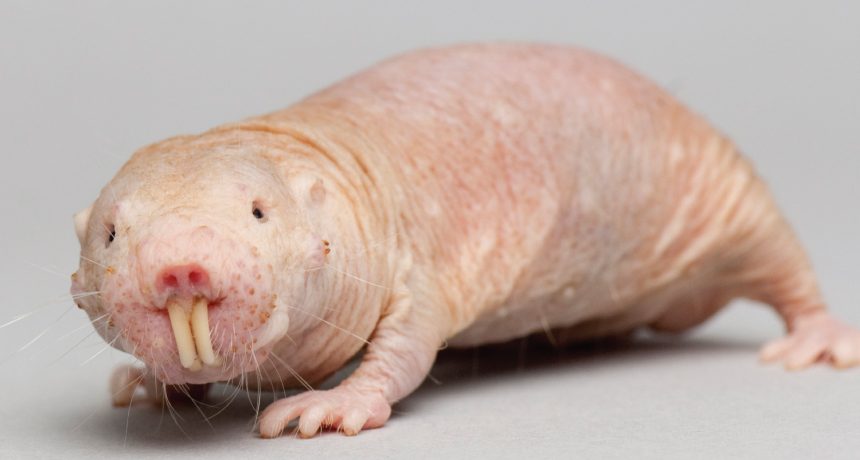A study has found that mole-rats can survive without oxygen, activating a plant-like mechanism that allows them to switch their energy source from glucose to fructose.
Scientists estimate that the mole-rat can survive up to 18 minutes without oxygen, whereas the ordinary mouse can’t survive more than 20 seconds. Naked mole-rats are among the strangest rodents, and one of the weirdest mammals. Other studies conducted on the mammals have found that they do not get tumors, that they’re immune to different types of chronic pain and also to the irritant in chili peppers.

Naked mole-rats can endure up to 18 minutes without any oxygen
Naked mole-rats live in East Africa in underground colonies of 300. In the colonies, there’s a mole-rat queen that gives birth to worker children, which don’t bear young mole-rats. Though they are mammals, they don’t regulate their internal body temperature, as they are cold-blooded like frogs. They can live up to three years, although “Old Man,” the world’s oldest mole-rat, died at 32.
Naked mole-rats can survive in oxygen-poor air, even at levels that would be deadly to mice or humans. Now, scientists have found that the naked mole-rat switches energy from glucose -which is the sugar that humans and most mammals use- to fructose, which is the sugar that plants use.

The study was published April 21 in the journal Science and was co-authored by Thomas Park, a neurobiologist from the Laboratory of Integrative Neuroscience at the University of Illinois at Chicago, and an expert on naked mole-rats. To prove the hypothesis, Park placed a naked mole-rat in a chamber containing 5 percent oxygen. The researchers noticed that the animal appeared unaware that most of the oxygen had vanished, and as fifteen minutes passed, the animal was still alive and well. The naked mole-rat from that experiment endured 300 minutes before showing a small sign of discomfort, and the scientists took her out of the chamber afterward.
“They didn’t even go to sleep,” told Park to The Washington Post.
The scientists then went on to test the naked mole-rat at 0 percent oxygen. They noted that the animals fell into a kind of suspended animation while being completely oxygen deprived. The mole-rats heart rate dropped from 200 beats per minute to 50. The scientists then added oxygen back to the chamber, and the animals recovered quickly.
“They were able to survive up to 18 minutes without any apparent neurological damage,” said Jane Reznick, study’s co-author and molecular biologist at the Max Delbrück Center for Molecular Medicine in Berlin, according to The Washington Post.
Researchers found that naked mole-rats switch to fructose when oxygen-deprived
The researchers knew that the naked rodents could survive without much oxygen, as previous studies indicated that the animal’s red blood cells, which transport oxygen, carried a version of hemoglobin that appears to make the cells extra efficient. Park noted that the oxygen in the rodent’s tunnels may lower at 8 or 10 percent oxygen and that no one has been able to test the air in their subterranean nests, where oxygen may drop even lower.
However, the scientist did not expect to find the fructose molecules present in the bodies of the oxygen-deprived naked mole-rats. The team used a technique called mass spectrometry to analyze the mole-rats’ vital organs, including their hearts and brains. The mass spectrometry analyzes tissue to find the vital organs, and the researchers tuned the spectrometer to search for different metabolites.

“Boy, that was a big pile of data across the desk,” said Park. “The fructose curves just jumped out.”
Fructose is sugar, as well as glucose, but organisms that use fructose as fuel, such as plants, and now the mole-rats, perform this without requiring oxygen as a primary metabolic component. Humans put their entire “chips” into the glucose pathway, according to Park. Although human cells have the required genetic information to build the fructose pathway, the cells are mostly inactive in vital organs like the heart and the brain.
In humans, the liver processes fructose and turns it into fat cells. Park believes that if human cells have the fructose information, maybe in a time of crisis people could trigger a mechanism such as the mole-rats’. The theory that science could turn the naked mole-rat biology into human therapy is hypothetical.
Park adds that the naked mole-rat needs to be further studied. Researchers discovered the rodents’ unusual endurance to pain in 2009 and scientists have only had the naked mole-rats’ genome sequence since 2011. Park believes that the new study could be a starting point for other neurobiologists and scientists, as they still don’t know where the fructose in the rodents comes from.
Source: The Washington Post
